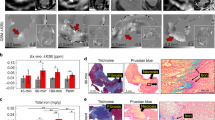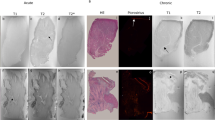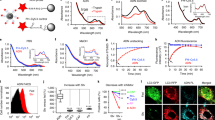Abstract
Molecular imaging agents can be targeted to a specific receptor or protein on the cardiomyocyte surface, or to enzymes released into the interstitial space, such as cathepsins, matrix metalloproteinases and myeloperoxidase. Molecular imaging of the myocardium, however, requires the imaging agent to be small, sensitive (nanomolar levels or better), and able to gain access to the interstitial space. Several novel agents that fulfill these criteria have been used for targeted molecular imaging applications in the myocardium. Magnetic resonance, fluorescence, and single-photon emission CT have been used to image the molecular signals generated by these agents. The use of targeted imaging agents in the myocardium has the potential to provide valuable insights into the pathophysiology of myocardial injury and to facilitate the development of novel therapeutic strategies.
Key Points
-
Targeted molecular imaging in the myocardium requires the imaging agent to be small (<50 nm), sensitive (nanomolar to picomolar levels), and able to gain access to the interstitial space
-
MRI has been successfully used to image necrosis, apoptosis, macrophage infiltration, and myeloperoxidase activity in the myocardium
-
SPECT imaging has been used to visualize necrosis, apoptosis, angiogenesis, and matrix metalloproteinases in injured myocardium
-
Fluorescence techniques possess many desirable attributes for molecular imaging of the myocardium but, at present, are limited to invasive approaches in humans
-
Several novel imaging agents, suited to targeted molecular imaging in the myocardium, have already completed phase III clinical trials
This is a preview of subscription content, access via your institution
Access options
Subscribe to this journal
Receive 12 print issues and online access
$209.00 per year
only $17.42 per issue
Buy this article
- Purchase on Springer Link
- Instant access to full article PDF
Prices may be subject to local taxes which are calculated during checkout




Similar content being viewed by others
References
Sosnovik DE et al. (2007) Molecular magnetic resonance imaging in cardiovascular medicine. Circulation 115: 2076–2086
Wu JC et al. (2007) Cardiovascular molecular imaging. Radiology 244: 337–355
Jaffer FA and Weissleder R (2005) Molecular imaging in the clinical arena. JAMA 293: 855–862
Wagner A et al. (2003) Contrast-enhanced MRI and routine single photon emission computed tomography (SPECT) perfusion imaging for detection of subendocardial myocardial infarcts: an imaging study. Lancet 361: 374–379
Meoli DF et al. (2004) Noninvasive imaging of myocardial angiogenesis following experimental myocardial infarction. J Clin Invest 113: 1684–1691
Su H et al. (2005) Noninvasive targeted imaging of matrix metalloproteinase activation in a murine model of postinfarction remodeling. Circulation 112: 3157–3167
Khaw BA et al. (1980) Myocardial infarct imaging of antibodies to canine cardiac myosin with indium-111-diethylenetriamine pentaacetic acid. Science 209: 295–297
Khaw BA et al. (1986) Scintigraphic quantification of myocardial necrosis in patients after intravenous injection of myosin-specific antibody. Circulation 74: 501–508
Hofstra L et al. (2000) Visualisation of cell death in vivo in patients with acute myocardial infarction. Lancet 356: 209–212
Narula J et al. (2001) Annexin-V imaging for noninvasive detection of cardiac allograft rejection. Nat Med 7: 1347–1352
Nahrendorf M et al. (2006) Factor XIII deficiency causes cardiac rupture, impairs wound healing, and aggravates cardiac remodeling in mice with myocardial infarction. Circulation 113: 1196–1202
Shah DJ et al. (2005) Technology insight: MRI of the myocardium. Nat Clin Pract Cardiovasc Med 2: 597–605
Einstein AJ et al. (2007) Estimating risk of cancer associated with radiation exposure from 64-slice computed tomography coronary angiography. JAMA 298: 317–323
Shen T et al. (1993) Monocrystalline iron oxide nanocompounds (MION): physicochemical properties. Magn Reson Med 29: 599–604
Wunderbaldinger P et al. (2002) Tat peptide directs enhanced clearance and hepatic permeability of magnetic nanoparticles. Bioconjug Chem 13: 264–268
Weissleder R et al. (1992) Antimyosin-labeled monocrystalline iron oxide allows detection of myocardial infarct: MR antibody imaging. Radiology 182: 381–385
Schellenberger EA et al. (2004) Magneto/optical annexin V, a multimodal protein. Bioconjug Chem 15: 1062–1067
Sosnovik DE et al. (2005) Magnetic resonance imaging of cardiomyocyte apoptosis with a novel magneto-optical nanoparticle. Magn Reson Med 54: 718–724
Hiller KH et al. (2006) Assessment of cardiovascular apoptosis in the isolated rat heart by magnetic resonance molecular imaging. Mol Imaging 5: 115–121
Nahrendorf M et al. (2007) Dual channel optical tomographic imaging of leukocyte recruitment and protease activity in the healing myocardial infarct. Circ Res 100: 1218–1225
Weissleder R et al. (2005) Cell-specific targeting of nanoparticles by multivalent attachment of small molecules. Nat Biotechnol 23: 1418–1423
Sosnovik DE et al. (2007) Fluorescence tomography and magnetic resonance imaging of myocardial macrophage infiltration in infarcted myocardium in vivo. Circulation 115: 1384–1391
Kanno S et al. (2001) Macrophage accumulation associated with rat cardiac allograft rejection detected by magnetic resonance imaging with ultrasmall superparamagnetic iron oxide particles. Circulation 104: 934–938
Chen JW et al. (2006) Imaging of myeloperoxidase in mice by using novel amplifiable paramagnetic substrates. Radiology 240: 473–481
Weissleder R and Ntziachristos V (2003) Shedding light onto live molecular targets. Nat Med 9: 123–128
Dumont EA et al. (2001) Real-time imaging of apoptotic cell-membrane changes at the single-cell level in the beating murine heart. Nat Med 7: 1352–1355
Ohnishi S et al. (2006) Intraoperative detection of cell injury and cell death with an 800 nm near-infrared fluorescent annexin V derivative. Am J Transplant 6: 2321–2331
Chen J et al. (2005) Near-infrared fluorescent imaging of matrix metalloproteinase activity after myocardial infarction. Circulation 111: 1800–1805
Harisinghani MG et al. (2003) Noninvasive detection of clinically occult lymph-node metastases in prostate cancer. N Engl J Med 348: 2491–2499
Kooi ME et al. (2003) Accumulation of ultrasmall superparamagnetic particles of iron oxide in human atherosclerotic plaques can be detected by in vivo magnetic resonance imaging. Circulation 107: 2453–2458
Trivedi RA et al. (2004) In vivo detection of macrophages in human carotid atheroma: temporal dependence of ultrasmall superparamagnetic particles of iron oxide-enhanced MRI. Stroke 35: 1631–1635
Shamsi K et al. (2006) A summary of safety of gadofosveset (MS-325) at 0.03 mmol/kg body weight dose: phase II and phase III clinical trials data. Invest Radiol 41: 822–830
Botnar RM et al. (2004) In vivo molecular imaging of acute and subacute thrombosis using a fibrin-binding magnetic resonance imaging contrast agent. Circulation 109: 2023–2029
Katoh M et al. (2007) Molecular MRI of thrombosis using novel fibrin-specific contrast agent: initial results in humans at 3.0 T. Proc Int Soc Magn Reson 9: 100
Pichler BJ et al. (2006) Performance test of an LSO-APD detector in a 7-T MRI scanner for simultaneous PET/MRI. J Nucl Med 47: 639–647
Kircher MF et al. (2003) A multimodal nanoparticle for preoperative magnetic resonance imaging and intraoperative optical brain tumor delineation. Cancer Res 63: 8122–8125
Acknowledgements
DE Sosnovik and R Weissleder were funded by NIH grants. R Weissleder also received funding from the Donald W Reynolds Cardiovascular Clinical Research Center, Harvard Medical School, Boston, MA, USA.
Author information
Authors and Affiliations
Corresponding author
Ethics declarations
Competing interests
Ralph Weissleder is a consultant for and a stockholder in VisEn Medical, Woburn, MA, USA. The other authors declared no competing interests.
Rights and permissions
About this article
Cite this article
Sosnovik, D., Nahrendorf, M. & Weissleder, R. Targeted imaging of myocardial damage. Nat Rev Cardiol 5 (Suppl 2), S63–S70 (2008). https://doi.org/10.1038/ncpcardio1115
Received:
Accepted:
Issue Date:
DOI: https://doi.org/10.1038/ncpcardio1115
This article is cited by
-
Cryopreservation of primary human monocytes does not negatively affect their functionality or their ability to be labelled with radionuclides: basis for molecular imaging and cell therapy
EJNMMI Research (2016)
-
Targeted Nanoparticles for Cardiovascular Molecular Imaging
Current Radiology Reports (2013)
-
Cardiomyocyte Death: Insights from Molecular and Microstructural Magnetic Resonance Imaging
Pediatric Cardiology (2011)
-
Molecular and Microstructural Imaging of the Myocardium
Current Cardiovascular Imaging Reports (2010)
-
Diffusion MR tractography of the heart
Journal of Cardiovascular Magnetic Resonance (2009)



